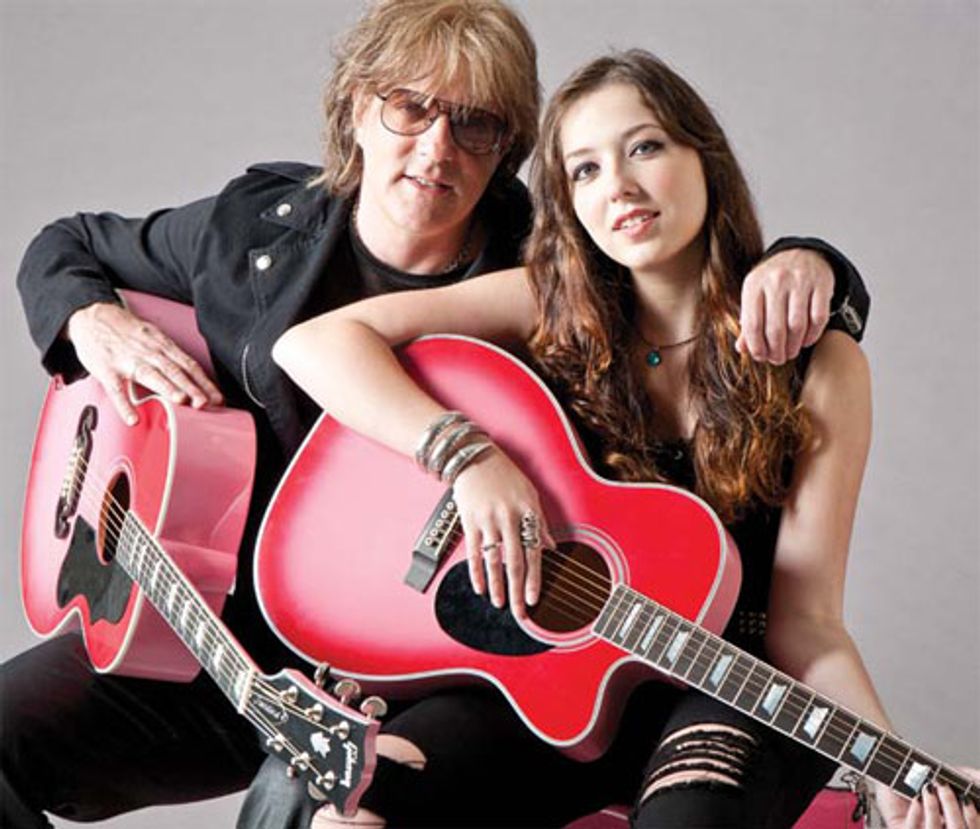
Jay Jay French and his daughter, Samantha, cradle the Gibson J-200 and Martin 000-18 flattops he commissioned to raise money to combat the rare eye disease Samantha has suffered from since she was 6 years old.
If you’re a child of the ’80s or hip to Reagan-era hard rock, John French Segall (aka Jay Jay French) needs no introduction. As co-lead guitarist for Twisted Sister, he cranked out fistpumping melodic anthems like “We’re Not Going to Take It” and “I Wanna Rock” that gave voice to the angst and rebellion felt by whole swaths of youth eager to indulge in everything their parents feared and hated. Those anthems brought French and Twisted Sister worldwide album sales of more than 15 million units, in addition to 37 gold and platinum awards from eight countries.
But even if you’ve never been into that particular music scene, you can probably relate to French as a gear nut— he’s famous for his trademark “pinkburst” Les Pauls. If you’re a parent, you’ll probably also identify with what he faces as the devoted father of a 17-year-old girl, especially as you read on and try to imagine what it was like when French and his (then) wife learned that Samantha, then 6, had uveitis—a disease that causes inflammation of the middle layer of the eye and that is the leading cause of blindness among American girls (see “What Is Uveitis?” sidebar on p. 5). Regardless of your musical or gear proclivities, you’ll likely feel pangs of empathy as you contemplate the 11 intervening years of pain, uncertainty, and heartache as French’s family learned to live with the disease.
French didn’t want to just live with it, though. As a restless rocker and a vigilant dad, he wanted to do something to help the cause. So three years ago he began the Pinkburst Project—an effort to amass a collection of one-off custom guitars and amps that could be auctioned to raise both awareness about uveitis and money to fund research for a cure. French commissioned Fender, Paul Reed Smith, Epiphone, Gretsch, Martin, Gibson, Marshall, Vox, Mesa/Boogie, Hartke, Diamond Amplification, Finland’s Ruokangas Guitars, and Orange to design a lineup of 25 exquisite guitars, basses, and amplifiers to that end, while TKL designed one-of-akind cases for the axes, Red Monkey created customized straps, and Harley Hoffman of Kayline Industries supplied the custom vinyl covering for the amps.
We recently spoke to French about his family’s struggle with uveitis, what led him to begin the Pinkburst Project, and what it was like selecting the gorgeous guitars, amps, and accessories that comprise it (we’re displaying selected portions of the project here, but you can view the entire collection at pinkburstproject.org).
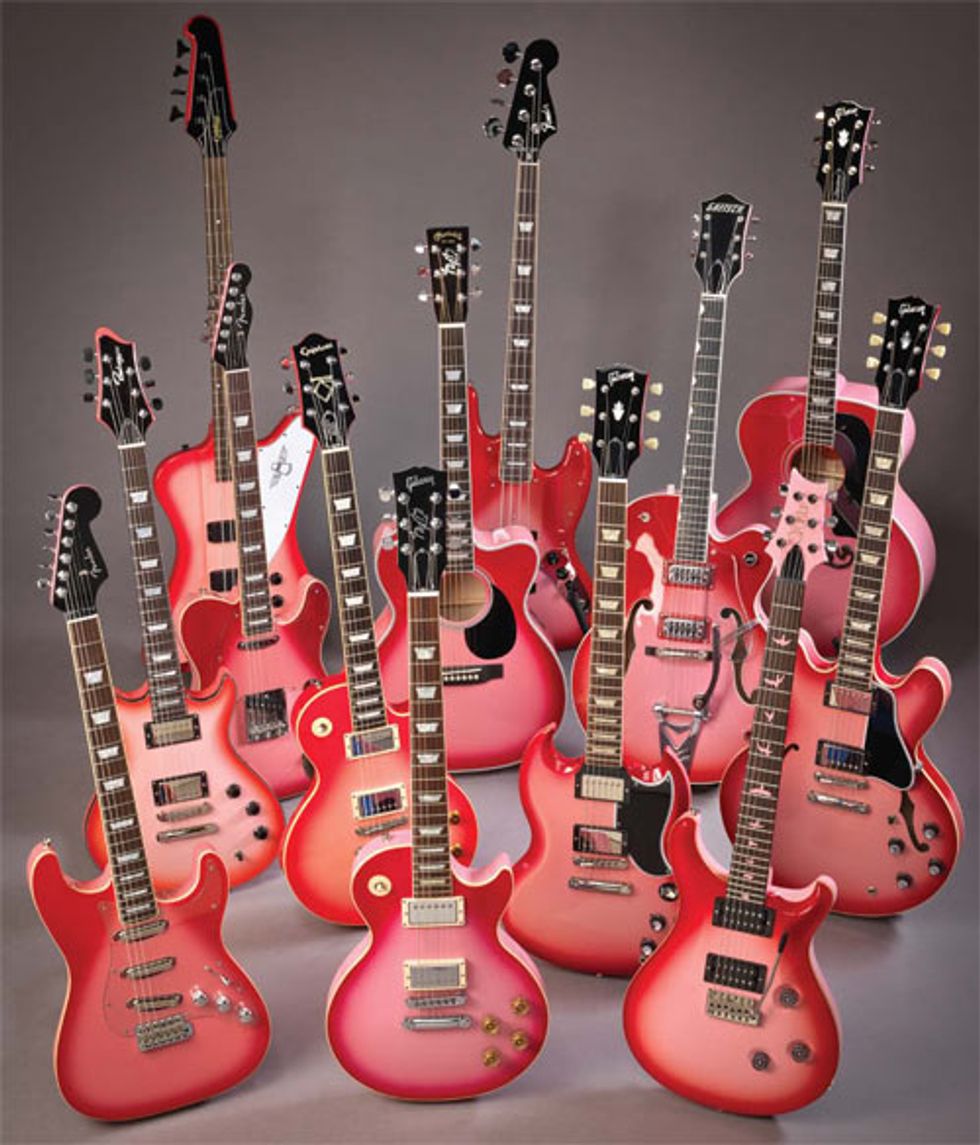
The Pinkburst Guitars – Front row (left to right): Fender Custom Shop Stratocaster, Gibson Custom Shop Les Paul, PRS Custom 24. Second row: Ruokangas Duke Custom, Epiphone Jay Jay French Elitist Les Paul, Gibson Custom Shop SG, Gibson Custom Shop ES-335. Third row: Fender Custom Shop Telecaster, Martin 000-18, Gretsch G6120. Fourth row: Epiphone Thunderbird, Fender Custom Shop ’75 Jazz Bass Reissue, Gibson J-200.
Can you take us back to what started all this—Samantha’s uveitis diagnosis?
Samantha was examined at school by a very young doctor who saw something unusual and suggested we see another doctor. I live in New York City, where Dr. Brian Herschorn looked at Samantha and saw it in two seconds. He said, “You’d better sit down.” Uveitis is an autoimmune condition, and a majority of girls with juvenile rheumatoid arthritis [JRA] have uveitis. If you have JRA, you have a 75 percent chance of developing uveitis. If you have uveitis, you have a 20 percent chance of developing JRA. As a parent, you suddenly find yourself learning about something you never heard of.
How horrifying. What happened next?
With uveitis, all roads lead to Dr. Stephen Foster at MERSI, the Massachusetts Eye Research and Surgery Institution. We went to Boston and he explained the prognosis. The problem with this disease is that many doctors throw topical steroids at it, but they can cause blindness if they’re overused, because they cause cataracts. Dr. Foster’s research said that systemic chemotherapy drugs are the way to go. Because of the connection to juvenile rheumatoid arthritis, they had to do a lot of tests to ensure that Samantha had nothing else, so it was an entirely long-term thing, with constant observation and multiple doctors— including JRA specialists—to monitor her while she was on medication. The two systemic drugs are cancer drugs—Methotrexate and Remicade. They use drops to lower the inflammation immediately and systemic drugs to hold back inflammation. A certain percentage of girls between 17 and 18 go into remission, because the body’s immune system develops and the body stops it. You take your child to checkups every three, six, and nine weeks, and you pray that the cells did not come back. And then come the drops to pull them back, and how many cells and floaters are in the back of the eye, and with every step backward, your heart sinks.
Methotrexate and remicade are potentially toxic, right?
Yes, absolutely. Methotrexate did not work. Remicade is a wonderful drug with two problems. First, it costs $20,000 a dose—or $19,700 if you have insurance—and is administered intravenously in a cancer ward. Second, it lowers the immune system so much that you get sick all the time. But it holds back the inflammation. Samantha went to New York-Presbyterian Hospital for a threeyear period for the monitoring of possible juvenile rheumatoid arthritis complications that come with uveitis. But she would look around at kids with cancer and say, “They are way worse off than me.” She went through treatment, was clear for six months, and then it came back with a vengeance and she had to start on a new drug called CellCept. It’s an organ-rejection drug that she took for two or three years, and it held the inflammation back. Her vision is 20/20 now with contacts—she’s nearsighted, like her parents—but she has the beginning of cataracts because of the eye drops.
CellCept is self-administered, so the efficacy is debatable, because my daughter had to take three pills twice a day and not eat for two hours before or after taking the medication. There had to be another way. So now she is on HUMIRA, which is injected every two weeks by a doctor, and she has responded well. She’s been on it for four months and her eyes are clear. She will stay on it for two years and then wean off of it and see what happens.
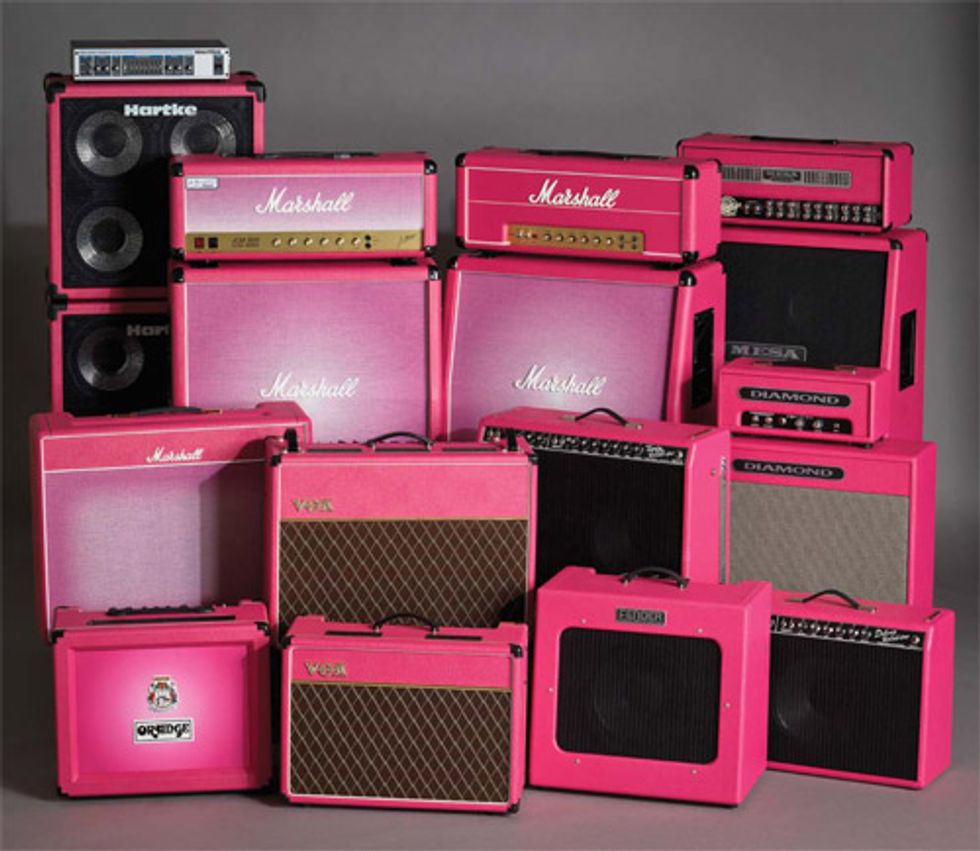
The Pinkburst Amps – Front row (left to right): Orange Rocker 30, Vox AC15C1, Fender TV Twelve,
Fender ’65 Deluxe Reverb. Second row: Marshall JTM-45 Bluesbreaker reissue, Vox AC30C2,
Fender ’65 Twin Reverb reissue, Diamond Amplification Positron head and cab. Third row: Hartke
HA2500 head and 410XL cabs, Marshall JCM800 head and 1960A 4x12 cab, Marshall 1959 Super
Lead reissue head and 1960A cab, Mesa/Boogie Dual Rectifier head and 4x12 cab.
Does she still see Dr. Foster?
Dr. Foster sees her, as does Dr. C. Michael Samson, of New York Eye and Ear Infirmary, who was trained by Dr. Foster. Dr. Herschorn, Dr. Samson, and Dr. Foster are in the loop with Samantha, her mother, and me.
With your touring schedule, were you able to attend her appointments?
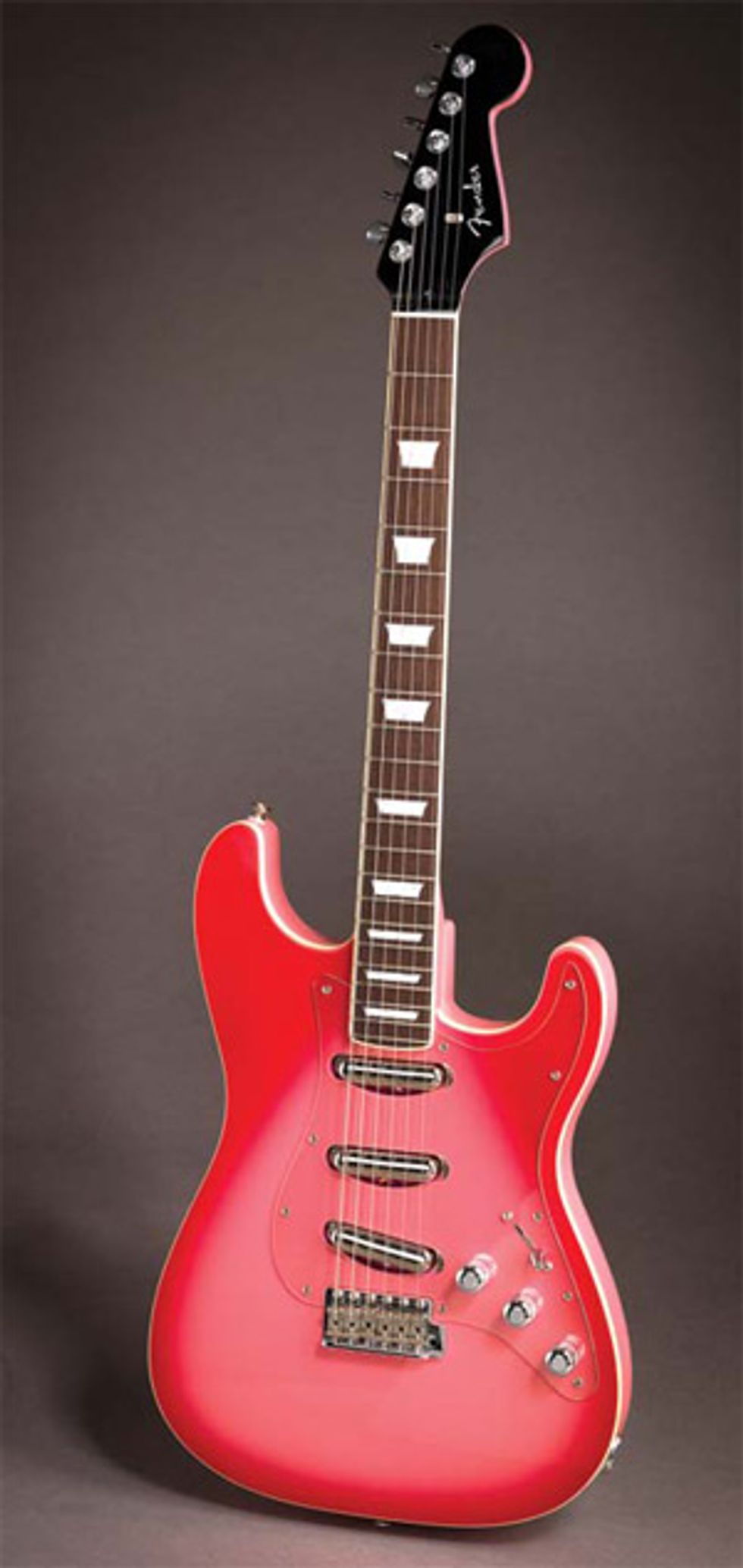 |
You were also lucky to have insurance—they don’t give cancer drugs away as samples.
We are very lucky, because Remicade will bankrupt you. It is the most expensive drug in the world. When you’re a parent whose child has a chronic disease, you have enough battles to fight, and it becomes an even tougher challenge due to the financial strain if you don’t have insurance—which is another reason I want to raise research dollars.
Which leads us to the Pinkburst Project. One day you woke up and thought . . .
I’d had my pinkburst Les Paul signature model for a long time, and at a NAMM show I was introduced to John Cruz from Fender. I told him I had a pink Les Paul and asked what it would take to build a pink Tele with rosewood—a custom guitar. He looked at me as if I were nuts. The guy who happened to be standing next to him was someone I hadn’t seen in 30 years—he was the kid who delivered my first Les Paul to me. It was eerie! I have an Epiphone Les Paul, and I had a Gibson Les Paul painted pink by a local luthier named Steve Carr in 1979. He’s the same guy who made the Axe bass for Gene Simmons. I had this boat-anchor, thousand-pound guitar delivered to me in a parking lot in Long Island, and there I was with the same guy standing next to John Cruz. John said, “Okay, I’ll make the Tele.”
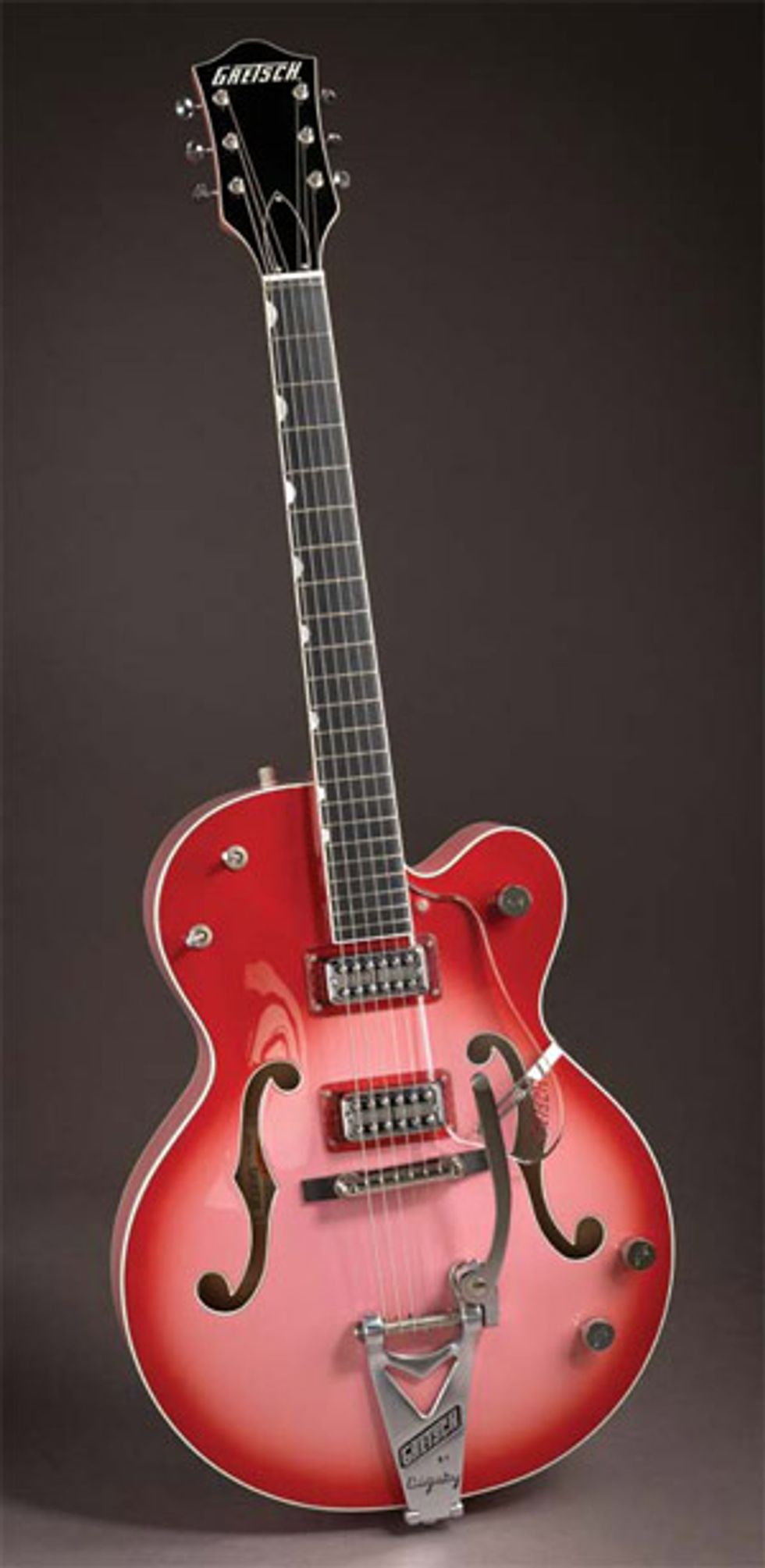 |
Is this your first fundraiser for MERSI?
I’ve been involved in auctions for the hospital. They do simple auctions where people donate typical things, and I donated guitars. This time, I wanted to do more.
How did you involve other manufacturers?
John was working on the Tele at his bench in California, and people would see it in the factory. I called him about a Strat, and then I talked to Martin and Gibson. By then we were in our second year of guitar models. And then came basses—and they all had to be pinkbursts. I could have bought guitars and had them painted, but the key was having the manufacturers make official guitars. That’s what matters to collectors—that they get that official slip. Once I explained the reason for this, everyone was onboard.
Did you request common features from all the manufacturers?
My wish list included trapezoid fretboard inlays—which we got on all but three of the guitars—rosewood fretboards, and matching colors. But, as Obama says, it involved the art of compromise, to a degree. So I had to compromise. Some of the guitars were made in China and had certain set inlays, fretboards, etc. After three years, I’d say this is quite a success story, with 99 percent of my wish list fulfilled.
Does each piece have a unique serial number or identifying stamp?
Every amp has a brass plaque with the Pinkburst Project logo, and every guitar has a custom-made TKL case with the project logo. Everything was so disparately made that the custom shops put their own numbers on them. All the serial numbers are available on the website.
So you didn’t make any other special requests— for instance, regarding necks, pickups, or frets?
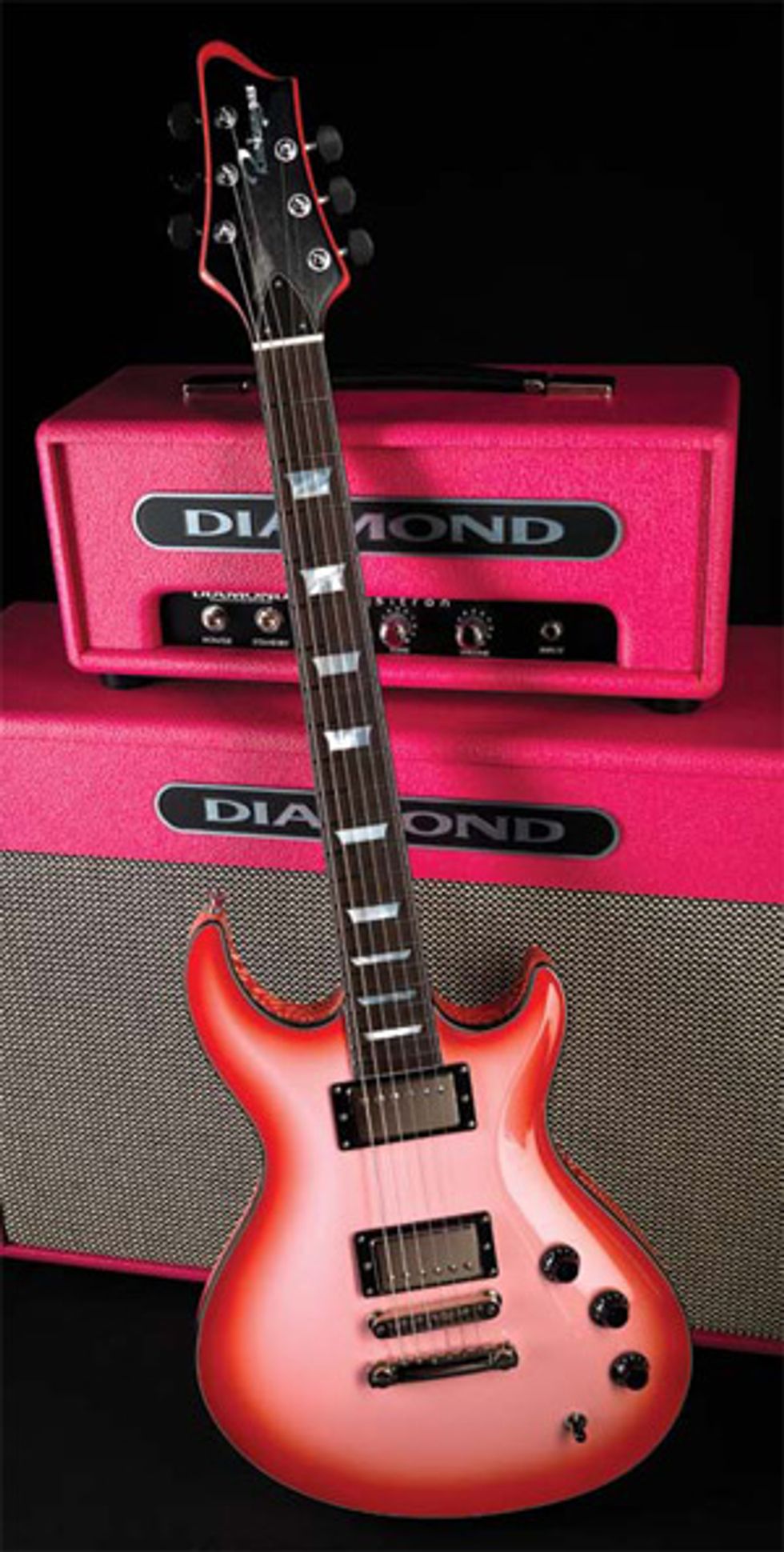 |
Are there any other ways that you’re planning to raise money year-round and from musicians who would love to own a pinkburst but can’t afford one?
Red Monkey made straps with the logo, and they will probably make extra ones to auction off and help the cause. They are affordable for someone who just wants to do something to help. The possibilities of other things are endless, but we had to focus on the singular reason or it would drive me crazy. I had to keep my eye on the ball or lose my mind. People say, “How much will this make?” It could bring in the minimum bid or it could bring in way more. If they’re all sold, it will probably make enough to send a nice check to the hospital. If enough people read about it and understand the uniqueness, then it can appeal to the vintage guy, the collector, the one-of-a-kind guy, someone who wants a pairing. I tried to get gear that would create a passionate connection to a broad base of people. The guitar and amp companies were very fair, and some didn’t charge me at all. I was surprised at some of the largesse that was shown to me.
With this project, I found something that is more important than my life. Putting myself out there on my daughter’s behalf has been so rewarding. It resonates with people. MERSI needs research dollars. People need help. I can’t thank all the manufacturers who participated enough. It is one thing to sit at your desk and dream of an idea, and quite another to have it realized. In addition to the philanthropic aspect to the Pinkburst Project, as a guitar player and collector, this is a dream come true. Many of these companies’ products have provided years of pleasure and satisfaction to me through the very same guitars, amps, and cases that are featured in this collection. I will remain a collector of many of the models represented in the Pinkburst Project—as well as other fine instruments and amplifiers—for the rest of my life.
The Pinkburst Auction
The Skinner Auction House in Boston will host the Pinkburst Project auction May 1, 2011, to benefit ongoing work at the Massachusetts Eye Research and Surgery Institution on behalf of the Ocular Immunology and Uveitis Foundation.
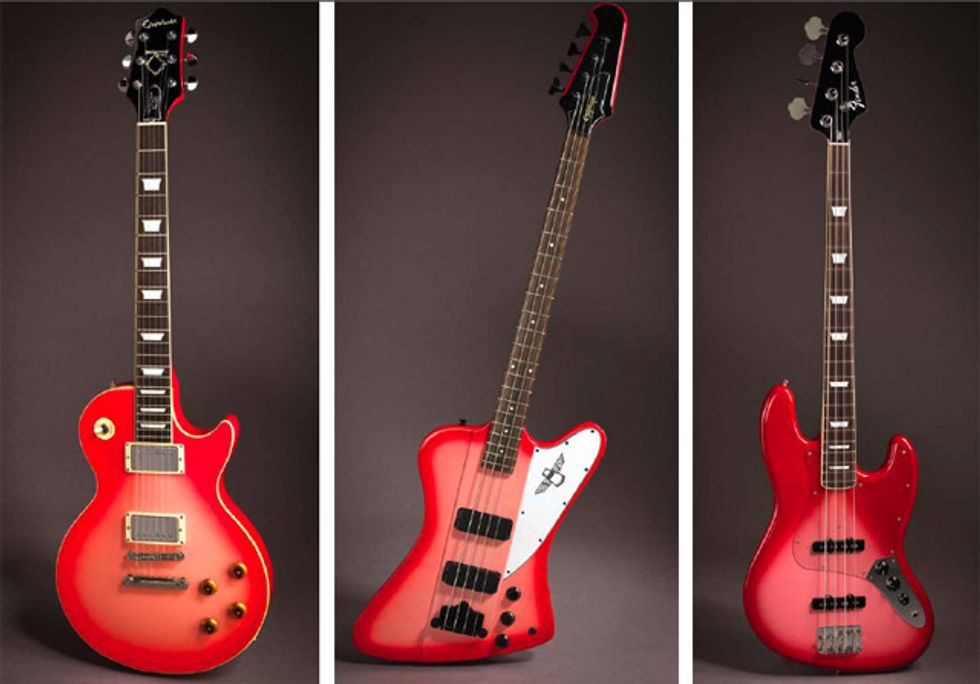
Epiphone Jay Jay French Elitist Les Paul (LEFT) and Thunderbird Bass (CENTER) – “When Jay Jay approached Epiphone about contributing a special guitar for this project, we were more than happy to help,” says Epiphone’s Jim Rosenberg. “Jay Jay and Twisted Sister have been die-hard supporters and users of Epiphone product for almost a decade now—not to mention that the cause is a worthy one. Contributing one of Jay Jay’s signature Les Paul pinkburst guitars was obviously a cornerstone of the concept and a perfect fit. However, when I found out he was gathering an assortment of instruments and had not considered a bass yet, a Thunderbird in pinkburst immediately came to mind.” The Les Paul features a Twisted Sister logo inlay on the headstock, Gibson-manufactured components, a long neck tenon, and a solid maple top. Fender Custom Shop ’75 Jazz Bass Reissue (RIGHT) – “I took a little different approach in the construction of this bass, as I really did not want to steer too far away from the original look of this classic,” says Fender’s John Cruz. “The body was again made of mahogany, but I decided to make the neck with quartersawn maple for better stability, with a 12"-radius Indian rosewood fretboard, trapezoid inlay and Fender logo inlayed into the peg face. I used our medium jumbo fretwire for this because I felt it worked better with the playability of a bass.”
What is Uveitis?
In layman’s terms, uveitis is inflammation of the uvea—the middle section of the eye. The third-leading cause of blindness among girls in the US, uveitis is rare and incurable, but with early detection it can be treated. Because there are no physical symptoms, it goes unnoticed by the patient until their vision is impaired.
Jay Jay French’s daughter, Samantha, now 17, was diagnosed at age 6 during what her father describes as “a very routine, rudimentary eye exam at school.” Further examination was recommended, which led the family to the Massachusetts Eye Research and Surgery Institution in Cambridge, where Samantha came under the care of Dr. Stephen Foster. “MERSI specializes in inflammatory diseases, and Dr. Foster is the leading specialist,” says French.
Uveitis is often associated with other medical conditions, including infection, trauma, and autoimmune diseases such as rheumatoid arthritis—and particularly juvenile rheumatoid arthritis. In patients with the disease, the immune system attacks what it mistakenly perceives as foreign bodies, resulting in severe inflammation that must be treated with pain medication, steroids, and, in extreme cases, potentially dangerous drugs. “Behind the uvea lie hundreds of thousands of capillaries, the smallest capillaries in the body,” says French. “If uveitis is not caught quickly, the immune system kills the lens and causes glaucoma and blindness. You can hold it back, and in some cases it goes away for reasons that doctors cannot understand.”
According to French, who has immersed himself in learning about the disease, little is known about uveitis. “It’s not a ‘sexy’ disease with hundreds of millions of dollars in research. Lack of detection adds to our country’s medical costs. As the parent of a child with a chronic disease, I know enough to explain to people what they need to do. I also know enough to tell them that early detection is the key. If treated early, chances are that a person will have normal sight for the rest of their life. Samantha is still in treatment and has preserved her eyesight, but had the cellular damage not been diagnosed, she could have been blind by now.”
For more information on uveitis, visit uveitis.org, uveitis.net, and the Massachusetts Eye Research and Surgery Institution at mersi.us.
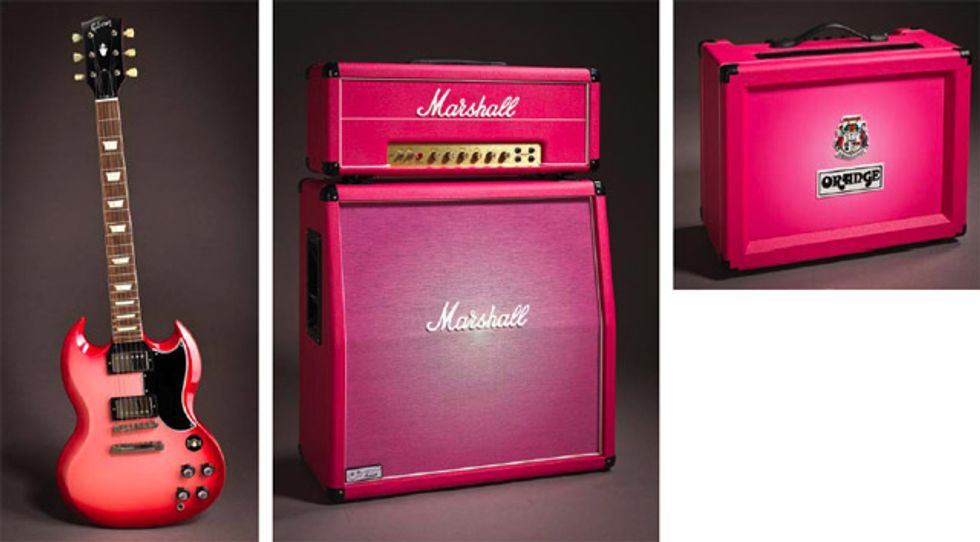
Gibson Custom Shop SG (LEFT) – “I worked with Jay Jay on three guitars,” says Gibson’s Steve Christmas, “the Les Paul Standard, the SG Standard Reissue based on a 1962, and a ’63 ES-335 Block Reissue. All three were built in the Gibson Custom Shop by our Pro Shop luthiers. All three have a slim-taper neck and are standard production models with the Pinkburst finish—which has never been duplicated on any other models in the Custom Shop.” Marshall 1959 Super Lead Reissue and 1960A 4x12 (CENTER) – “Marshall has been my company exclusively for 35 years,” says French. “When I told them what I wanted, they said, ‘You’re family. We’ll do whatever it takes.’” Orange Rocker 30 (RIGHT) – The class A, 30-watt Rocker features two EL34-driven channels, a Celestion Vintage 30 speaker, and grill cloth screen-printed by Jeron Moe at Eloquent Creative. “I spoke to Alex Auxier from Orange Amps at NAMM,” says French. “One day he called me and said, ‘What’s the name of that disease again? My best friend’s girlfriend has it. We want to be involved.’”
Fender's John Cruz on Making Pinkburst Project Guitars, Basses, and Amps
Master Builder John Cruz from the Fender Custom Shop in Corona, California, first met Jay Jay French at the Winter 2007 NAMM show. He was in the midst of conversation with co-workers outside the Fender booth when the guitarist approached him.
“Jay Jay walked right up to me and joined in on our conversation,” says Cruz. “He was telling me about this wacky dream he had about having a pinkburst guitar custom built for him. He said he had a huge array of Gibsons but really had not had a great Fender to add to his collection—especially with the left-field specs that he was thinking about. He wanted a Telecaster in a hot pink color with a cherry-red burst around it. He wanted most of the appointments that were on all of his Gibsons to be present, as well. He sent me his Gibson Les Paul to use for reference, which helped a lot in getting the color right. I told him, ‘Your sick dream is my pleasure.’”
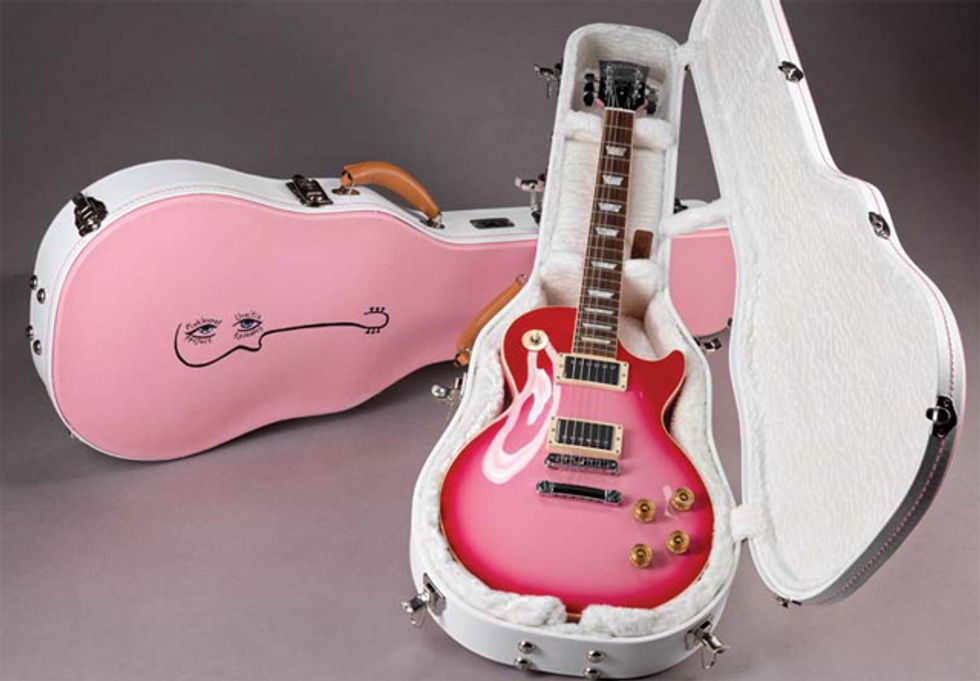
TKL Cases – All Pinkburst Project guitars come with a custom TKL case adorned with the Pinkburst Project logo (the one shown here holds a pinkburst Gibson Custom Shop Les Paul), and a Red Monkey Pinkburst Project leather guitar strap in pink, white, or black.
The guitar was finished in February 2008, and by that time the Pinkburst Project was under way. “I remember this guitar sounding incredible and really did not want to see it leave my hands,” says Cruz. “Jay Jay received the guitar and was very excited about the whole vibe. He started showing it to other musicians and manufacturers, who were blown away and really wanted to be involved.”
Next was the custom Stratocaster, which Cruz describes as “My favorite guitar in the world. Jay Jay wanted the same appointments as the Tele to be present. It really seemed weird to be putting trapezoid inlay on a Strat, but we are the custom shop, where your dream is our specialty.” French’s next request from Fender was a ’75 Jazz bass. “He chose that because he had a real ’75 and loved the way it felt, sounded, and played.”
The last guitar was a Gretsch G6120. “I really do not build Gretsch guitars, but I spoke with our Senior Master Builder, Stephen Stern, about what I was doing,” says Cruz. “He said he had a cancelled order for a 6120 in his area that needed a home. It just needed to be finished up with detail sanding, and then to be painted and built.”
With the Gretsch complete, Cruz thought Fender had come through on everything French wanted. Then came the final request: “Jay Jay said, ‘I gotta have matching amps to pair with all these guitars.’ I said, ‘Dude, you’re killing me.’ So I spoke with [thenartist relations manager] Alex Perez about his quest and he was glad to help out. I got to see these beauties right before the chassis was installed. They stood out like a sore thumb. The women here at the plant fell in love with them, as did everyone else. They all knew I had something to do with this project and have since not looked at me the same way. Thanks, Jay Jay, for tarnishing my reputation!”
Cruz looks back on the two-and-a-half-year undertaking with great pride and some humor, but he also has quite a heart for the cause and obvious admiration for French’s efforts and determination. “The whole idea gave me a great feeling about what this long-haired, Twisted Sister-vest-wearing, thug-looking guy was up to,” he says. “I hope whoever gets these babies will enjoy them as much as I did putting my all into them.”






![Rig Rundown: Russian Circles’ Mike Sullivan [2025]](https://www.premierguitar.com/media-library/youtube.jpg?id=62303631&width=1245&height=700&quality=70&coordinates=0%2C0%2C0%2C0)

















